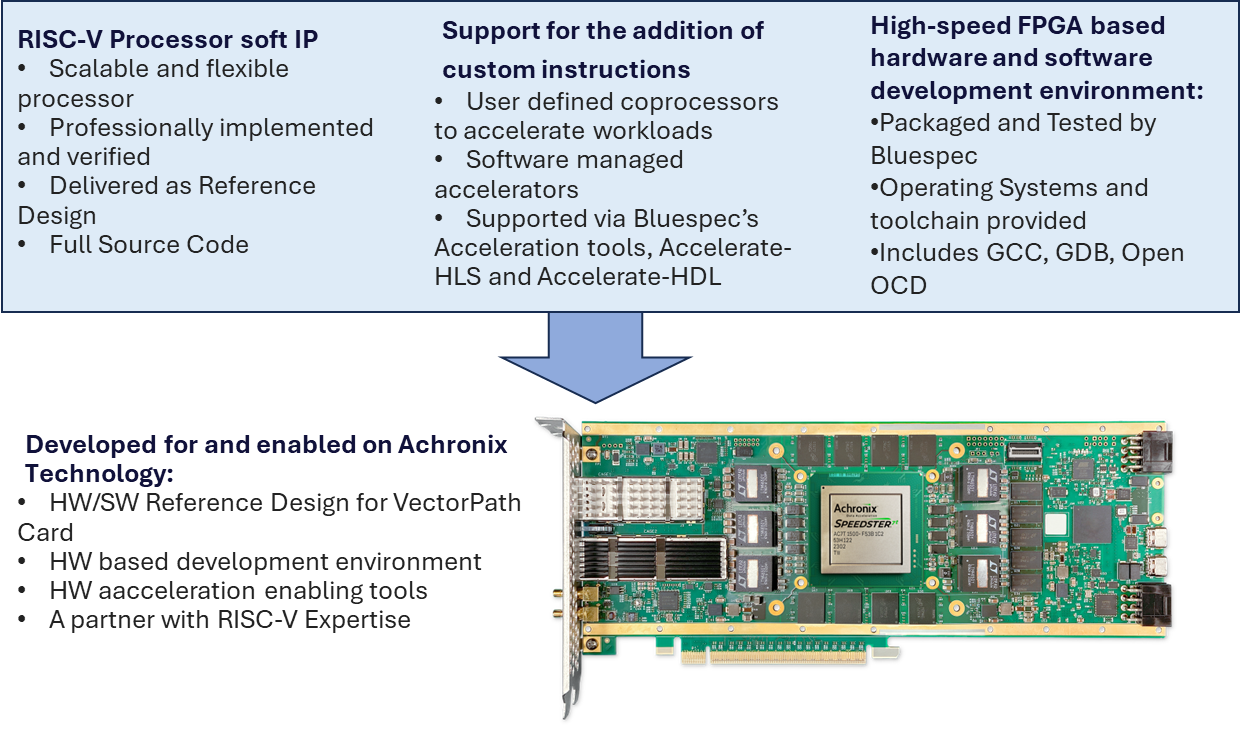RISC-V PROCESSORS
FOR ACHRONIX FPGAs
Scalable Programmability with Bluespec RISC-V Soft Processors
Bluespec, Inc., offers a portfolio of RISC-V processors provided as soft-IP for use in Achronix Speedster®7t FPGAs. Bluespec's processor offering ranges from a single RISC-V processor to multi-core RISC-V Linux processors featuring a five-stage processor subsystem that can run Linux out of the box on Achronix FPGAs. Bluespec's RISC-V processors also support custom instructions, enabling engineers to add accelerators managed through software to their Achronix FPGA designs.
The RISC-V processors are highly configurable and can be tailored to the user's application requirements,
balancing performance with resources. These processing subsystems are built to take advantage of the
scalability enabled by the Achronix 2D network on chip (2D NoC), which enables designers to incorporate one or more independent processor subsystems operating in a Speedster7t FPGA.
Powered by Speedster7t FPGAs
The Speedster7t FPGA family is optimized for high-bandwidth workloads and eliminates the performance bottlenecks associated with traditional FPGAs. Built on the TSMC 7nm FinFET process, Speedster7t FPGAs feature a revolutionary new 2D network-on-chip (2D NoC), an array of new machine learning processors (MLPs) optimized for high-bandwidth and artificial intelligence/machine learning (AI/ML) workloads, highbandwidth GDDR6 interfaces, 400G Ethernet and PCI Express Gen5 ports. The 2D NoC connects all of the interfaces to over 80 access points in the FPGA fabric to deliver ASIC-level performance while retaining the full programmability of FPGAs.
-v10-20240321_122032.bmp)
Target Applications
AI/ML acceleration – Enables efficient processing of complex models and algorithms, crucial for AI driven applications.
Data center workloads – Provides customizable acceleration to enhance cloud computing, improving
performance and efficiency in data processing tasks.
Networking and communications – Facilitates high-speed data processing and advanced networking
functionalities essential for robust communication systems.
High-performance computing (HPC) – Supports demanding computational tasks in scientific
research and simulations, offering scalability and high-speed processing capabilities.
Benefits of Integrated RISC-V Soft Processors in Speedster7t FPGAs
Efficient Processor Communication - The 2D NoC ensures high-bandwidth, low-latency communication between multiple RISC-V cores and
accelerator functions hosted in the FPGA fabric. This communication is critical for applications that require coordinated processing across multiple cores, improving overall system performance.
Scalable Multi-Core Architectures - With the 2D NoC facilitating efficient data movement, designers can quickly scale their RISC-V-based systems within the FPGA. More RISC-V cores can be added for the application without significantly increasing design complexity or compromising performance.
Enhanced Data Processing Capabilities - The high bandwidth provided by the 2D NoC allows the RISC-V cores to quickly access large datasets from
memory interfaces or external I/O, crucial for data-intensive applications such as machine learning inference, high-speed packet processing, and real-time analytics.
Optimized Power Efficiency - The combination of Bluespec RISC-V cores and the 2D NoC leads to an overall reduction in power consumption. The efficient data routing minimizes unnecessary data movement and processing, ensuring that the FPGA operates efficiently, which is especially important for edge computing devices and applications with limited power resources.
Simplified System Design And Integration - The architectural coherence between the 2D NoC and the RISC-V cores simplifies the system design process. Developers can focus on leveraging the computational capabilities of the RISC-V cores without worrying about the complexities of data routing and interconnect bandwidth, speeding up the development cycle and reducing time to market.
Complete Hardware/Software Stack for Achronix FPGAs

Technology Specifications:
|
FEATURES |
MCU/MCU-X MICRO-CONTROLLER |
BMR BAREMETAL/RTOS |
SCL SINGLE CORE LINUX |
MCL 2,4,8,16-CORE LINUX |
|
ISA* |
RV32IMCX |
RV32/64IMA[FD]CX |
RV32/64IMA[FD]CX |
RV32/64IMA[FD]CX |
|
Custom extensions |
yes |
yes |
yes |
yes |
|
Microarchitecture |
multi-cycle |
5-stage |
5-stage |
5-stage |
|
Virtual memory |
no |
no |
yes |
yes |
|
Caches |
no |
4K-64K |
4K-64K |
4K-64K |
|
Tightly-Coupled Memories |
4K-128K |
no |
no |
no |
|
Physical Memory Protection |
no |
yes |
yes |
yes |
|
Branch prediction |
NA |
yes |
yes |
yes |
|
6-input LUTs (Processor and additional IP) |
1.6K – 2.2K |
12K – 22K |
24K – 50K |
75K – 750K |
|
FPGA Fmax |
100 – 330 MHz |
50 – 240 MHz |
50 – 225 MHz |
25 – 150 MHz |